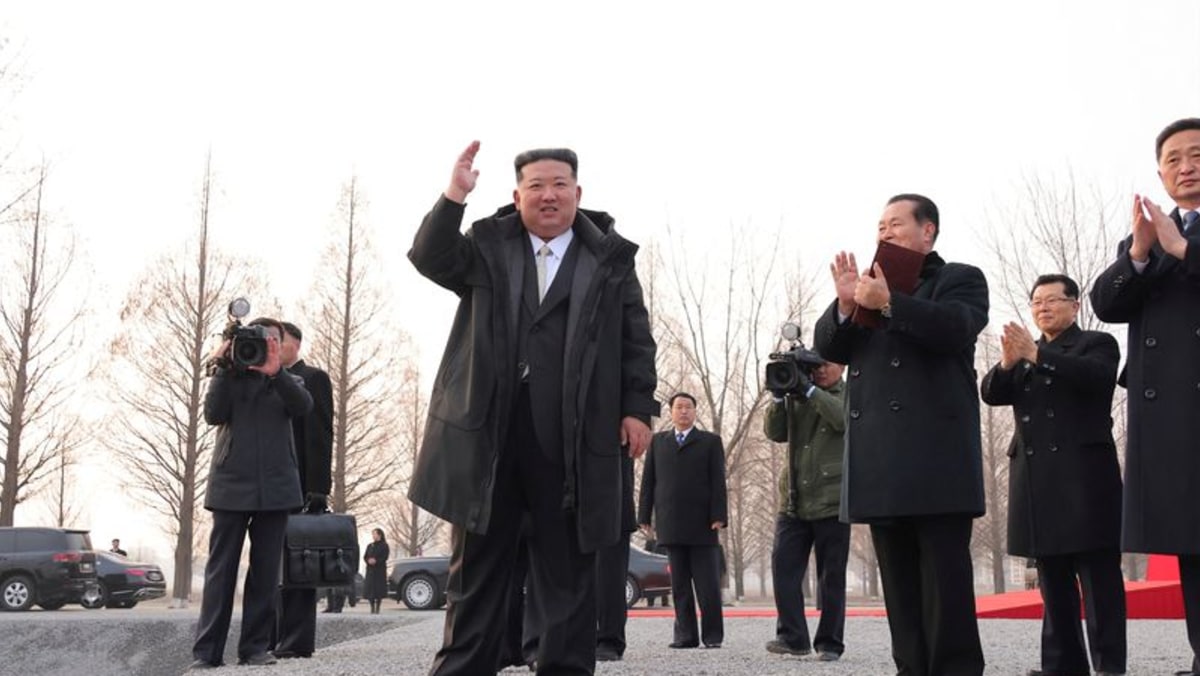Asia
North Korea’s Kim makes rare visit to father’s tomb

Kim Jong Un Pays Respects to His Father on His Birthday
On February 16, North Korean leader Kim Jong Un visited the Kumsusan Palace of the Sun in Pyongyang to honor the birthday of his late father, Kim Jong Il. This significant event was reported by the state-run Korean Central News Agency (KCNA) on Monday, February 17. The birthday of Kim Jong Il, who ruled North Korea from 1994 until his death in 2011, is celebrated as a major national holiday known as the "Day of the Shining Star." This day holds immense cultural and political significance in North Korea, as it commemorates the legacy of the former leader and reinforces the centralized leadership of the ruling Kim dynasty.
A Rare Visit After Four Years
Notably, this was Kim Jong Un’s first visit to the Kumsusan Palace of the Sun in four years to mark his father’s birthday. The mausoleum serves as the final resting place for both Kim Jong Il and his father, Kim Il Sung, the founder of North Korea. The embalmed bodies of the two leaders are preserved there, and the site is a symbol of the regime’s efforts to perpetuate the cult of personality surrounding the Kim family. By visiting the palace, Kim Jong Un reaffirmed his connection to his predecessors, a crucial aspect of maintaining legitimacy and continuity in North Korea’s authoritarian political system.
The visit was not conducted alone; Kim Jong Un was accompanied by his sister, Kim Yo Jong, who holds a senior position in the ruling Workers’ Party of Korea, as well as other high-ranking officials. The presence of Kim Yo Jong, who has emerged as a prominent figure in North Korean politics, underscored the importance of family ties in the country’s governance. The KCNA described Kim Jong Un’s actions as being conducted "in the humblest reverence," highlighting his devotion to his father’s legacy and the ideals of the Kim dynasty.
A Commitment to the Nation’s Prosperity
During his visit, Kim Jong Un reportedly expressed a "solemn will to devote himself to the sacred struggle for the eternal prosperity of the country, the security of the people, and the promotion of their well-being." This statement, as reported by KCNA, aligns with the broader narrative of the Kim regime, which portrays its leaders as selfless servants of the nation and its people. By emphasizing his commitment to the country’s prosperity and security, Kim Jong Un sought to reinforce his image as a dedicated leader who prioritizes the welfare of North Koreans above all else.
This public declaration also served as a reminder of the regime’s enduring goals, including the maintenance of political stability, economic development, and the preservation of North Korea’s unique identity on the global stage. The phrase "sacred struggle" reflects the regime’s portrayal of its efforts as a noble and ongoing fight against external challenges, including economic sanctions and geopolitical pressures.
The Evolution of Kim Jong Un’s Leadership
While the visit to the Kumsusan Palace of the Sun was a nod to tradition, it also highlighted the evolving nature of Kim Jong Un’s leadership. Since assuming power in 2011, Kim Jong Un has gradually sought to establish his own identity and authority, distinct from the shadows of his father and grandfather. Despite this, the Kim dynasty’s cult of personality remains a cornerstone of North Korea’s political culture, and public displays of reverence for his predecessors are essential for maintaining the regime’s legitimacy.
By visiting the mausoleum after a four-year absence, Kim Jong Un signaled his continued respect for the legacy of his father and grandfather, while also reinforcing his own position as the rightful leader of North Korea. This balancing act reflects the delicate interplay between tradition and modernization in the country’s governance, as well as Kim Jong Un’s efforts to consolidate power and ensure the long-term survival of the regime.
The Significance of the Day of the Shining Star
The Day of the Shining Star, as Kim Jong Il’s birthday is known, is more than just a personal commemoration; it is a carefully choreographed national event that reinforces the regime’s ideology and values. The celebration is marked by widespread ceremonies, parades, and public displays of loyalty to the Kim family. These events serve to strengthen the emotional and ideological bonds between the leadership and the population, fostering a sense of unity and shared purpose.
For North Koreans, the Day of the Shining Star is an opportunity to reflect on the achievements of the past and the aspirations for the future. It is a moment when the nation comes together to honor its leaders and reaffirm its commitment to the principles of self-reliance and independence that have defined North Korea’s history. By participating in this tradition, Kim Jong Un not only paid homage to his father but also reiterated his role as the guardian of these principles and the leader of the nation.
Conclusion: A Blend of Tradition and Modern Leadership
Kim Jong Un’s visit to the Kumsusan Palace of the Sun on the Day of the Shining Star underscores the enduring importance of the Kim dynasty’s legacy in North Korea’s political landscape. While the visit was a traditional act of respect, it also served as a strategic move to reinforce Kim Jong Un’s leadership and connection to his predecessors. By expressing his commitment to the nation’s prosperity and security, he sought to inspire confidence in his vision for the future while maintaining the stability of the regime.
As North Korea continues to navigate the complexities of the modern world, the interplay between tradition and innovation in its leadership will remain a critical factor in shaping its trajectory. For now, Kim Jong Un’s actions on the Day of the Shining Star signal his resolve to honor the past while charting a course for the future, ensuring that the legacy of his father and grandfather endures for generations to come.











